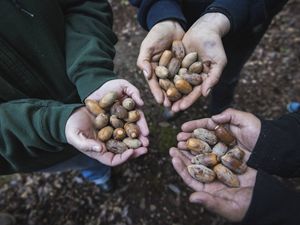Strong Voices, Active Choices
Partnering with Indigenous Peoples and local communities to achieve social and environmental outcomes
The Brazilian Amazon; East Africa’s savannas; Western Canada’s temperate rainforests; Northern Australia’s deserts: what do these habitats all have in common? They are massive carbon sinks, rich in wildlife—and much of their area is managed by Indigenous Peoples.
Twenty-five percent of the world’s land is managed by or designated for Indigenous Peoples and local communities. With their territories harboring more than 17 percent of the world’s forest carbon, and much of global biodiversity, Indigenous Peoples and local communities are among the Earth’s most important stewards. Their leadership is key to conservation and sustainable development of their own lands, the territories surrounding them and ecosystems globally.
Unfortunately, these groups face a number of barriers to making their vision for conservation and healthy communities a reality. Issues surrounding land rights and tenure are probably the most well-known challenges faced by Indigenous Peoples and local communities, but there are a range of other challenges stemming from power imbalances at local, national and global scales. Even when these communities do have land rights, they often are unable to engage effectively in land-use decisions, as they are excluded or under-represented in decision-making processes, or face outside pressure from encroaching development that threatens their cultural and environmental priorities on that land.
Download
The Nature Conservancy (TNC) is working to address these issues by creating and supporting opportunities for Indigenous peoples and local communities to play a stronger role in natural resource decision-making and management. TNC’s approach to partnering with Indigenous peoples and local communities on shared conservation and sustainable development goals is called the “Voice, Choice, and Action Framework”—or VCA framework for short.
Developed through an extensive literature review and evidence from current TNC projects, this framework describes TNC’s overarching theory of change for partnering with Indigenous peoples and local communities and is meant for use in situations where human well-being outcomes and conservation outcomes are linked and interdependent, where the leadership of Indigenous peoples and local communities is essential to achieving shared goals, where power imbalances may hinder achieving sustainable results for nature and people, and where projects may significantly impact local communities.
Quote
Indigenous Peoples and local communities are some of the most important partners in the global struggle to contain climate change and preserve biodiversity.
In Northern Australia, for example, traditional management of the savanna landscape has been in place for more than 40,000 years. But when colonization left clans dispossessed of their lands in the 19th and 20th centuries, interrupting natural patterns of Indigenous fire management among other environmental management activities, the savanna landscape became subject to increased wildfires that damaged habitat and released large amounts of greenhouse gases. Recently, large areas of land have been returned to the management control of Indigenous Peoples and with the support of TNC’s Northern Australia program, Indigenous partners are increasingly engaging in participatory planning for their territories—called Healthy Country Planning. Healthy Country Planning enables them to envision a future for their lands with economic opportunity that aligns with their cultural priorities. The deep linkage between the sustainable economic opportunities provided through reviving Indigenous land management practices like fire burning (e.g. via participation in carbon markets) is clear evidence that these partnerships achieve positive outcomes for people and nature.

Equitable and lasting positive results for people and nature generally requires the presence of the VCA Framework’s interdependent and mutually reinforcing four pillars and three foundational elements (see image below). The four pillars of the framework (rights, capacity, decision making, and livelihoods) represent the characteristics necessary for successful community-led conservation. The three foundational elements (equity, knowledge and place, and durability) represent enabling conditions critical for enduring community-led conservation.
When invited, TNC partners with Indigenous Peoples and local communities to co-create long-term solutions that center on the principles of Voice, Choice, and Action. Strong Voice elevates Indigenous and local knowledge, identity, local priorities, and values in plans and solutions. The ability to exercise and influence Choice builds leadership and effective engagement in decision-making. Greater Action means communities initiate and drive the implementation of programs and the management of resources that impact their well-being both now and in the future.
Download
Learn More
Dive deeper into our theory of change for partnering with Indigenous Peoples and local communities on shared conservation goals and explore case studies that illustrate each pillar and element in action at tncvoicechoiceaction.org.
Global Insights
Check out our latest thinking and real-world solutions to some of the most complex challenges facing people and the planet today.





